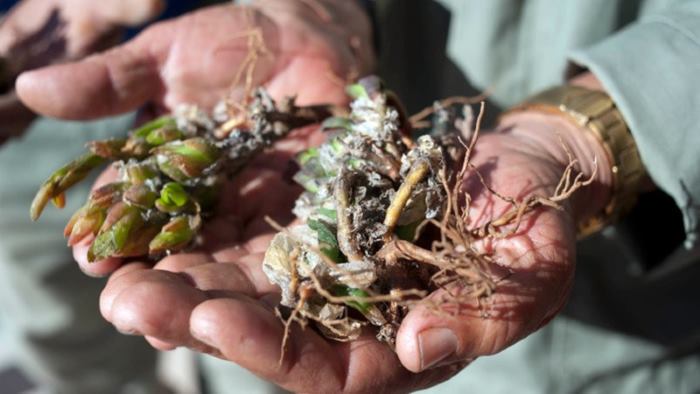Kanna: The Soothing Succulent of the San People

To understand Kanna, you have to understand one thing…
The culture of the Khoikhoi and San people.
These savage yet sophisticated tribes of Southern Africa are true warriors and hunter gatherers – and have been long into the depths of history.
Their hunts would go on for days and they would often return bloodied, worn and in need of care and recovery.
Well, chewing on a wad of kanna would be their "go-to" remedy after returning to their families!
But, the Khoikhoi would also call upon the powers of the kanna plant before embarking on these stressful hunting marathons.
Helping them to feel emboldened, less stressed, mentally sharp and tingling with euphoria.
In fact, this medicinal plant is interwoven in virtually all aspects of Khoisan life.
The Western world first found out about this in 1663, when a chap known as Van Riebeeck boldly ventured into the tribe's territory to barter – and received their two most prized assets in return – sheep and kanna!

But the world of modern science is only just beginning to catch up on the benefits of this herb!
With ground breaking studies released as recently as October 2019 - and dazzling new products now hitting the shelves of malls all around America.
So... read on to find out more about the little-known world of kanna.
What is Kanna?
Kanna (known locally as 'kougoed' or 'Sceletium Tortuosum' in Latin) is essentially a juicy looking succulent that grows close to the ground - and blossoms into an attractive plant with yellow flowers.

But the magic of the plant is contained in its roots, stems and leaves. These would traditionally be harvested – then either crushed between stones, or twisted into knotted ropes like tobacco - buried underground in a skin bag to ferment and then spread out in the sun to dry.
After this 8 day procedure, the San and Khoikhoi would chew, smoke or even snort the fermented material to feel its wide range of effects.
And chewing the stuff – literally all day long - was (and still is) by far the most popular way!
Because Kanna in San literally means 'something to chew'.
The herb was highly prized and used for a variety of medicinal and restorative purposes. There are reports as far back as 1789 of kanna tinctures being used as anaesthetic by Dutch farmers - adopting the time honoured tricks of the locals.
Kanna is also culturally connected to Eland Antelopes – the 'trance animal' of the San people.
The euphoric intoxication would encourage the tribespeople to feverously dance in celebration, during the ceremonial slaughter of the antelope!
We know much of this from the bold expeditions of the original Dutch settlers in the 17th century – in particular Van Der Stell's 'Journal of the Expedition into Namaqualand'. The production and popularity of kanna was so abundant at this time, that it was extensively documented by the curious Dutch explorers.

It fact, it was during these first expeditions that the 'Little Karroo' region became known as Kannaland – which remains a modern-day South African municipality now renowned for its cheese factories!
Kanna Effects – What Exactly Does The Kanna Plant Do?
The effects of kanna are unmistakable.
But it is not a hallucinogen in any sense.
It's more of a mild-grade narcotic that kills pain, relaxes the body and mind… and in higher doses causes euphoria and stimulation.
Modern day Khoikhoi report that the herb is used as a kind of social lubricant, similar to alcohol.
But the euphoria is said to be more peaceful and tranquil than alcohol - without the physical disorientation. It helps one to reach a relaxed and happy state, suited for inner-exploration and an appreciation of the profound beauty of nature.

And you can be assured – there are reputable scientific studies to prove all of this.
-
In this 2013 study, 17 healthy participants took a small amount of kanna extract and after being exposed to fearful stimuli, were shown to significantly less anxious.
-
Recent research published in October 2019 took 21 folks and gave them a small daily dose of kanna for 3 weeks. They found positive changes in mood and sleep – plus significantly improved cognitive flexibility and executive function.
What's the kanna high like?
It's worth remembering that the San people are well-known for chewing on kanna literally all day long, so the high (via chewing at least) is not overwhelmingly strong.
In fact, reports from a Namaqualand farmer commented that though his labourers and farm hands chewed the kanna plant all day, he was completely unable to tell – other than a bit of a 'faraway look' in their eyes.

Having said this, using it as snuff or smoking it will markedly increase the intensity of the high over chewing.
Here are a few examples of how the kanna high feels from Erowid.
"It is very effective, either alone or in combination with cannabis. It provides a dreamy, content state. There is an initial feeling of alertness, brightening of colors, and an internal warmth. This is followed by a giddy, light-headed, slightly drowsy state. You just can't put your finger on it."
- K
"Suddenly, everything's a little lighter, a little faster and ever so slightly dizzy. I would compare this to a small amount of alcohol, without being too physical. My mental state is sharpened, but there's no push as with a stimulant. Rather, this is a gentle lift in mood and faculties."
- Trichilia
"Elevated mood, great calmness, a bit of euphoria and joy, slightly more at ease with communication with people, warmth and connection with others. Clear, fast and structured thinking, clearer than with cannabis or alcohol. Warm body feeling, deep relaxation and a bit light headed/floaty but also very very drowsy."
- Frisco
Are there side effects?
One notable side effect of kanna is that if you take too much, you're going to feel very numb!
In fact – technically - anaesthesia can occur if you take too much.
Rood (1994) reported that if sufficient kanna is consumed, it will anaesthetize the lower jaw enough for dentistry work to be carried out - and it was medically used for this purpose in South Africa.
In a similar vein... if you take too much, you're likely to fall flat into a deep sleep within minutes!
There are also anecdotal reports of drowsiness, headaches and increased anxiety (although it's studied for reducing anxiety, in rare cases it has the opposite effect).
Of course – don't forget that all herbs have potential side effects – if they don't agree with you.
Generally, however, kanna is well-tolerated and recognised as safe.
Important Note: Never combine kanna with an SSRI or MAO (such an anti-depressants) as there's a risk you could induce potentially fatal serotonin syndrome.
How To Take Kanna
Kanna can be chewed, smoked or used as a snuff.
The roots, leaves and stems are all sources of the four main active alkaloids: Mesembrine, Mesembrenone, Mesembrenol and Mesembranol.

If you purchase a commercial mixture, it will likely be a combination of all these parts of the plant.
Note that if you're going the route of oral consumption, then the herb must be fermented. Otherwise it's simply too acidic to bear and will burn your tongue. Ouch!
There is good reason fermented kanna is popular and that kanna has always been fermented!
Don't mess with tradition!
Although for the purposes of chewing, the closest you will really get to the traditional preparation, is to get your fermented product and mix it with a piece of chewing gum! This can be chewed, held in the mouth between the gums (or under the tongue) and the saliva swallowed.
Smoking is the only method that could possibly be recommend for raw unfermented material.
Smoking Kanna – how?
If you'd like to smoke kanna, you have a few options.
Your best bet is to acquire some powder or extract and then use a 'dry herb vape' or a pipe.
Or if you want to be traditional like the San people, first chew on the fermented plant matter (minus the chewing gum... doh!) and then smoke the residue in a pipe afterwards when you're done with it!
You could however simply try purchasing a parcel of dried leaves and roll them into a cigarette.

A Short Note On Snorting Kanna
There's plenty of historical evidence relating to the use of kanna as snuff, so don't feel bad about insufflating in this way – especially considering that the plant is legal.
However, anecdotal reports suggest that this isn't the nicest feeling in the world.
To snort kanna, you will obviously need to acquire a very fine powder or extract. You would simply take a small amount and snort it in the normal way.
What's The Correct Kanna Dosage?
There's very little reliable information regarding the optimal kanna dose.
And there are a few valid reasons for this.
For a start, there are actually a large number of subtly different strains of this plant – which have not all been exhaustively categorised by science.
Different strains have different ratios and strengths of the active alkaloids. Which leads to them having subtly different effects. This strength of each plant is also subject to growing conditions and a range of other genetic factors.
Taking into account the manufacturing process of the powder or extract – it is quite unlikely you'll be able to tell exactly how strong the product that you've just purchased is. The exception is if you purchase a standardised kanna extract, made under strictly controlled conditions... like the folks in the below photo.

In very general terms, plant material ranges between 0.5 – 1.5% alkaloids.
And most studies have been completed with extracts equating to around 16-50mg of dry plant material. This would seem to equate to 1-2 leaves or a small amount of fermented root – of the right size to be comfortably placed in the mouth and chewed.
Just start off very small – perhaps a single leave – or a small pea-sized amount of powder.
Then gauge the effects of kanna yourself and slowly increase the dosage over time.
Kanna Tea
One of the most wonderful things I've seen lately is kanna tea. There's an charming company called Traditional Medicinals that you should really check out.

They've been a family business since 1974, are third generation herbalists – and focus heavily on environmental activism. They really do help to empower the indigenous communities in which the herb is grown.
Because their kanna is literally taken straight from the red soils of the Karoo desert.
You can check out the reviews on Amazon.
Like most herbs, tea tends to be the mildest of all the potential ways to take it.
So if you're curious to experiment, kanna tea is probably the safest and easiest way to dip your toes in the water.
Kanna powder
Sadly, it's unlikely you'll find a source of the traditional twisted root ropes that would be chewed by the natives.
If you do find one… let me know!
More likely, is that you will end up with some variety of dried, fermented kanna powder – since this has a much longer shelf-life and is more easily transported.
You can readily purchase such powder online – either in capsules, or in bulk bags
It's noteworthy that there's been a huge explosion in kanna research over the last 15 years. And a small number of top-tier botanical supplement manufactures have latched onto this because the traditional and scientific evidence backing up the effects of this plant is now very strong.
Along with the fact that it is currently completely legal.

For example, Zembrin is a high quality patented extract - which is effectively the ultimate kanna powder.
It's an evidence-based dietary supplement that has been studied for both safety and efficacy in comprehensive clinical studies. And these studies prove mood-enhancing, anxiety-reducing and cognitive enhancing effects.
It's always nice to know that the specific blend of material you are putting into your body has been thoroughly tested and studied. Along with the fact that the standardised 2:1 formula removes any concern around getting the correct dosage.
The company has also focused on the alkaloids that are less intoxicating - so you can experience the medicinal and cognitive benefits of the plant - without getting high.
So, Zembrin is another highly recommended way of experiencing kanna for the first time.
Note that this company is also socially responsible, ecologically sustainable and fully traceable from field to bottle.
Because they formally acknowledges and reward the contribution of the San people.
Which they've achieved through a formal benefit-sharing agreement with the South African San Council. In fact you'll notice the San Council's logo on the bottle, which is nice.

This photo shows the actual plantation in Karoo where Zembrin is cultivated.
The best way to get hold of Zembrin is in a supplement called Calm-Z by Doctor's Best Nutrition
Again, you can see the reviews on Amazon.
Is The Kanna Herb Legal?
The short answer is yes.
Kanna is legal across the USA, Canada, UK and Australia. In fact, at the time of writing, I've not been able to find any country in the world where it's illegal.
Although, as it continues to gain popularity over the next few years, the status of kanna legality could very well change - so don't hold your breath.
What Effect Does It Have On Your Dreams?
After all… we are a website all about lucid dreaming.
And my investigations into kanna came about as a result of its potential as dream enhancing agent.

As always I start with science… and I was able to find a solid study that proves kanna is actually an Acetylcholine Esterase Inhibitor.
For those that don't know, this is the chemical class that all lucid dreaming supplements fall into.
Both fermented and unfermented alkaloid extracts inhibited acetylcholinesterase, with IC 50 being 0.303 mg/ml and 0.330 mg/ml.
There are also a good number of anecdotal reports – such as this one - suggesting that kanna may well have oneirogenic properties.
"After playing around with this stuff the last 24hrs, I have experienced probably the most intense dream like state I can ever recall. Whilst sleeping I could not clearly distinguish whether I was sleeping, or if I was awake. I mean I was so immersed in the content of the dream it was… well, the most extraordinary dream state I can ever recall!"
In fact, the Encyclopedia of Mind Enhancing Foods, Drugs and Nutritional Substances by David W. Group states:
"Other effects may include greater personal insight, more sociability, a contemplative grounded feeling increased tactile and sexual response – and vivid dreams."
So the evidence for kanna as an oneirogen is strong.
Just make sure that when you chew or smoke it, you do so in combination with lucid dreaming techniques!
Final Thoughts
Kanna is an incredible traditional healing plant that still very much has a place in modern life.
In fact 2020 could be the year that the kanna herb finally goes mainstream.
Its effects are substantial and varied. You can use it to unwind after a hard day at work, feel calm before a party or barbeque - or even to enhance your dreams.
Enjoy!
[Image credits: David Harrison, M&G; HG&H Pharmaceuticals (Pty) Ltd.; Africa Geographic]















